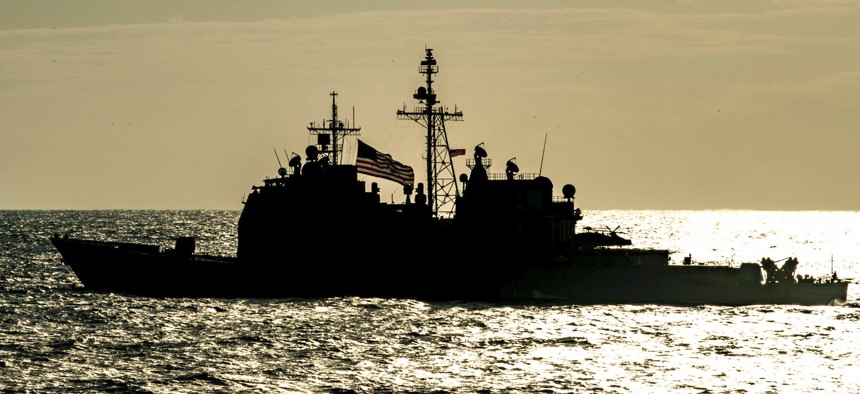
The USS Mobile Bay transits the Philippine Sea, Feb. 16, 2022, during Jungle Warfare 2022, a large-scale training exercise. Navy Petty Officer 3rd Class Taylor Crenshaw
Navy’s Next 30-Year Shipbuilding Plan Could Avoid Details–Again
Secretary Del Toro wants to give “decision space,” but lawmakers want specifics.
CORRECTION: The original version of this article mischaracterized statements by Navy Secretary Del Toro praising last year’s 30-year shipbuilding plan. The article and headline have been changed and additional statements included to indicate the fiscal 2023 plan is not yet finalized.
The Navy’s next 30-year shipbuilding plan expected to be submitted with the fiscal 2023 budget request could again be short on details, despite negative reactions when they did the same thing last year.
Navy Secretary Carlos Del Toro praised last year’s plan, saying on Wednesday that he favors transparency and clear definition of the Navy’s plans one decade out, but questioned the benefit of speculating too far into the future.
Del Toro said he thought last year’s 30-year plan “was handled well, but you're going to have to wait to see our reaction when we release the president’s 2023 budget.”
Speaking at a defense industry conference in Washington, D.C., Del Toro said, “Last year we did submit a range of ships in the shipbuilding plan, and although I won't reveal what we'll do this year, let me simply suggest that, you know, I think there's very clear definition in what a country or a nation like ours needs in the next 10 years for example, right? And it's important to provide that transparency and that definition, right? But as you go beyond 10 years from now, can you clearly indicate what the threats will be that our nation faces? And so I think it's important to have some decision space there to move in one direction or another.”
In June 2021, the Navy submitted with President Joe Biden’s first defense funding request a 16-page, 30-year shipbuilding plan for fiscal 2022 that indicated a range in the numbers of ships it wanted, such as nine to 11 aircraft carriers, and said that a more complete plan would not be available until the 2023 budget. That plan is still being finalized, according to a Navy official.
Del Toro said aerial drones like the MQ-9 Reaper, for example, have shown to be “transformative”–meaning that how the technology develops and how the Navy could use it are still hard to predict.
“It was a viable solution actually to have definition in the first 10 years, and then when you're looking beyond that, perhaps to have it a little more open to the possibilities that may exist as we test out these unmanned technologies and the concepts of operations that go along with them,” Del Toro said of last year’s plan.
But, he said the public will have to “wait till we actually release a shipbuilding plan to see what we're going to do this year.”
Earlier in the day, House Armed Services Subcommittee on Seapower and Projection Forces ranking member Rep. Rob Wittman, R-Va., told conference attendees he did not want a repeat of last year’s plan that would make Congress have to fill in the shipbuilding details over 30 years.
“It shouldn't be a range of ships, it should be ‘these are the number of ships that we need, this is what the plan is’--be as definitive as possible. That I think is incredibly important,” he said.
Detailed plans allow Congress to see and question the number and variety of ships the Navy wants, when they will be built, and how the service intends to stay on track to meet the expected needs of the future Navy, like the new Columbia-class nuclear submarine.
Chief of Naval Operations Adm. Mike Gilday said in February to expect at least 500 ships, including unmanned vessels, in their long-range shipbuilding plan.
“If we aren't careful, sometimes you can get bogged down in what you think the needs are today instead of trying to be forward looking. And I want to make sure that we're forward looking in what happens, and especially as we integrate unmanned systems,” Wittman said.
Del Toro told reporters he knows some in Congress will want specific numbers on drone vessels, but others are “quite comfortable actually talking about a range of numbers,” based on his impression of how it was received last year.
Del Toro was sworn in as secretary in August, a few months after the 2022 plan was released.
“When you take a look at the numbers of unmanned platforms, small or large, that might be needed in the Department of Navy, it's really hard to predict the exact number, you know, 20, 30 years out. And so I think it's a viable option to what was done in the 2022 presidential budget, to take that approach,” he said.
In the shorter term, Rep. Mike Rogers, R-Ala., the top Republican on the House Armed Services Committee, on Wednesday called on the Navy to begin building three attack submarines yearly, instead of two, to meet Gilday’s 500-ship goal.
“Building two attack subs a year is not going to cut it, it’s not going to put a dent in our 66-sub goal,” he said, at a submarine industry conference in Washington.




